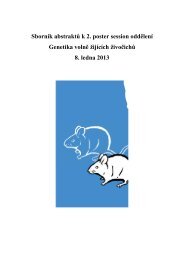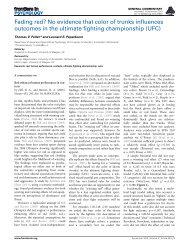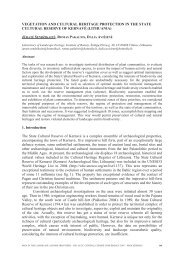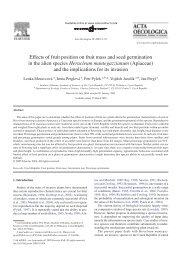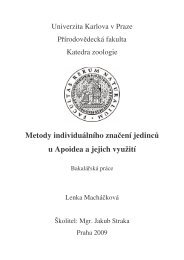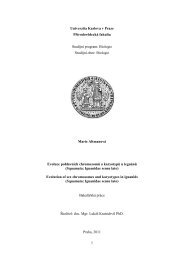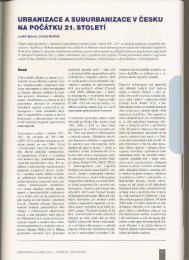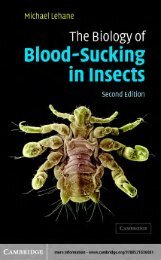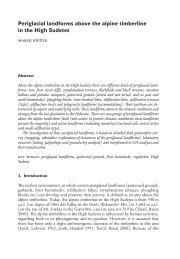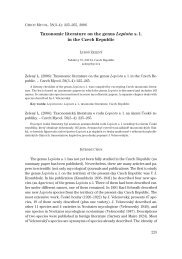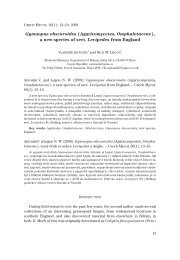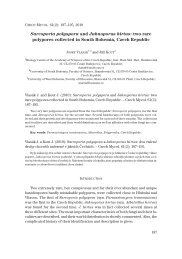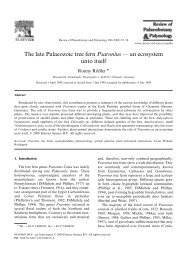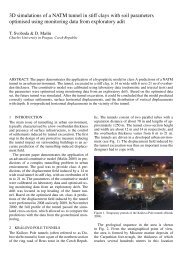The wood-rotting bluing Psilocybe species in Central Europe – an ...
The wood-rotting bluing Psilocybe species in Central Europe – an ...
The wood-rotting bluing Psilocybe species in Central Europe – an ...
Create successful ePaper yourself
Turn your PDF publications into a flip-book with our unique Google optimized e-Paper software.
<strong>Psilocybe</strong> moravica Borovička var. moravica, Mykol. Sborn. 80(4): 127 (2004)<br />
P. moravica c<strong>an</strong> be recognised by the follow<strong>in</strong>g comb<strong>in</strong>ation of macrocharacters:<br />
pileus often not umbonate, convex, sometimes nearly pl<strong>an</strong>e or almost<br />
hemispherical, marg<strong>in</strong> sometimes somewhat wavy at maturity, lamellae with<br />
a grey t<strong>in</strong>ge <strong>an</strong>d broadly ventricose at maturity, stipe with silvery velar remn<strong>an</strong>ts<br />
on dark background <strong>an</strong>d often with a well-developed fibrillose <strong>an</strong>nular zone (this<br />
feature has never been observed <strong>in</strong> <strong>an</strong>y other <strong>Psilocybe</strong> <strong>species</strong> of the Stirps<br />
Serbica). Microscopically, P. moravica is characterised by relatively large spores,<br />
clearly broader th<strong>an</strong> <strong>in</strong> P. bohemica (Fig. 2). <strong>The</strong> normal spore length r<strong>an</strong>ge is<br />
11.0<strong>–</strong>13.5 μm, longer spores are relatively rare <strong>in</strong> some collections. Pleurocystidia<br />
are present (scarce to abund<strong>an</strong>t), basidia 4<strong>–</strong> <strong>an</strong>d 2-spored, often with markedly<br />
large sterigmata, 4<strong>–</strong>6(<strong>–</strong>8.5) μm long.<br />
P. moravica c<strong>an</strong> be confused with P. arc<strong>an</strong>a. However, the latter <strong>species</strong> is<br />
characterised by its somewhat smaller spores, absence of pleurocystidia, basidia<br />
with small sterigmata (up to 5 μm long), chocolate-brown lamellae with a purple<br />
t<strong>in</strong>ge, a stipe often enlarged (deformed) at apex <strong>an</strong>d always lack<strong>in</strong>g a fibrillose <strong>an</strong>nular<br />
zone.<br />
D i s t r i b u t i o n . Known from more th<strong>an</strong> 15 localities <strong>in</strong> the Czech Republic<br />
(Moravia), Austria, Italy <strong>an</strong>d Slovakia.<br />
P h e n o l o g y. September—November; it c<strong>an</strong> be also found <strong>in</strong> July or August,<br />
if the summer season is cold; fructification maximum <strong>in</strong> October/November.<br />
Selected illustrations.Assisi et al. (2008, p. 298<strong>–</strong>300), Borovička (2003,<br />
figs. 10 <strong>an</strong>d 11, 9 colour plates), Borovička (2006, fig. 1), Galli (2003, p. 44; as P.<br />
cy<strong>an</strong>escens), Galli (2005, p. 53; as P. cy<strong>an</strong>escens), ? Gartz (1996, fig. 2; as P.<br />
cy<strong>an</strong>escens), ? Gartz (1999, fig. 3.4; as P. cy<strong>an</strong>escens).<br />
C o l l e c t i o n s e x a m i n e d . BRA CR3465, BRA CR3466, BRA (16 Oct. leg. J. Kuth<strong>an</strong>), BRNM<br />
331888, L (19 Oct. 2006 leg. J. Borovička), PRM 851189, PRM 895095, PRM 900455 (holotype), PRM<br />
900987, PRM 900988 (paratype), PRM 900989, PRM 900990, PRM 900991 (paratype), PRM 900992<br />
(paratype), PRM 901022, PRM 901023, PRM 905435, PRM 905485, PRM 905486, PRM 905487, PRM<br />
905488, PRM 905501, <strong>an</strong>d PRM 905515.<br />
I have been study<strong>in</strong>g the <strong>species</strong> of the stirps Serbica at their orig<strong>in</strong>al localities<br />
<strong>in</strong> the Czech Republic for years <strong>an</strong>d I have observed that the comb<strong>in</strong>ations of characters<br />
described above are const<strong>an</strong>t; no <strong>in</strong>termediate collections have been found.<br />
On the other h<strong>an</strong>d, I have seen several aberr<strong>an</strong>t (or <strong>in</strong>termediate) collections from<br />
various sites <strong>in</strong> <strong>Europe</strong>, especially as herbarium specimens (IB 78/422, PRM 846609,<br />
PRM 869528, PRM 901024, PRM 901173, PRM 901178, PRM 905505, PRM 909789,<br />
PRM 909889 <strong>an</strong>d PRM 909970).<br />
Moser <strong>an</strong>d Jülich (1996, pl.: III <strong>Psilocybe</strong> 5) reported a colour photo of<br />
„<strong>Psilocybe</strong> callosa“. However, Agaricus callosus is a synonym of P<strong>an</strong>aeolus<br />
papilionaceus (Bull.) Quél. (Guzmán 1995), <strong>an</strong>d P. callosa sensu Guzmán (1983),<br />
188<br />
CZECH MYCOL. 60(2): 173<strong>–</strong>192, 2008



